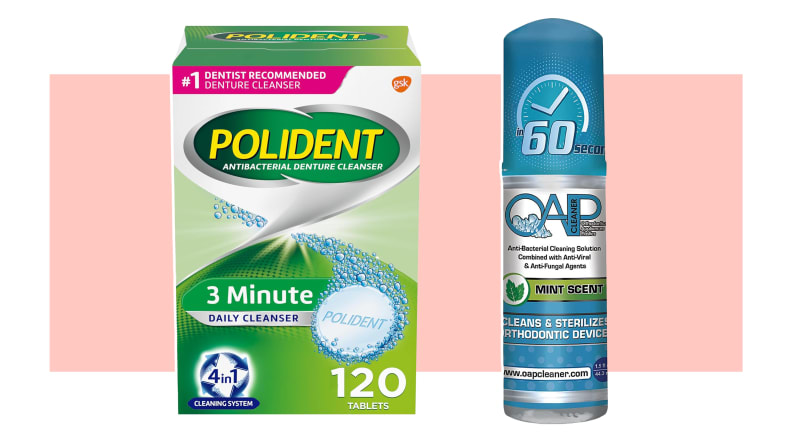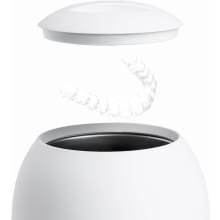How to clean a retainer or dentures by tablet or brush
Refreshen your mouth in seconds
 Credit:
Reviewed / OAP / Arm & Hammer / Anna Wenner
Credit:
Reviewed / OAP / Arm & Hammer / Anna Wenner
Products are chosen independently by our editors. Purchases made through our links may earn us a commission.
If you’re reading this article, then you (like me) probably dread cleaning your retainer or dentures. It can be unpleasant at the best of times to look too closely at any mouth-related accessories, and getting them truly clean can feel like a herculean task. As you may already know, standard toothpaste and mouthwash won’t cut it either, making the process all the more confusing.
Luckily, the brilliant minds behind dental products understand the average user’s aversion to this chore. Store-bought retainer cleaners can get the job done in anywhere from 60 seconds to 15 minutes. There are also some super simple DIY options that are just as effective, though using them may require a little more work on your end.
Keep reading to learn how to clean dentures, retainers, and other oral appliances with some of the best (and simplest) products. Though our testing focused on retainers, most of these cleaning products and tips can also be applied to other tooth-related accessories like mouth guards, aligners, and dentures. When in doubt, always check with your dental provider to see which method they recommend for your item.
How to clean your retainer by soaking

If you're using a soaking solution to clean your retainer or dentures, remember to keep the water lukewarm and not too hot.
Step 1: Gather your materials
Here’s everything you need to set up a fast and gentle clean through soaking.
- Your retainer or dentures (ideally directly after wearing it so it’s still moist)
- Cup or container to hold water
- Chosen retainer or denture cleaner
- Phone or timer
Step 2: Fill your container with warm water
It’s important that the water is lukewarm rather than hot when soaking dentures or a retainer, because extreme heat can be a dental accessory’s worst enemy. Using hot water can cause warping that makes the retainer unusable, and it won’t matter how clean the retainer is if you can no longer wear it.
Step 3: Create the solution and place the retainer inside
If you’re using a premade solution, make sure to read the instructions and follow the steps listed on the box to get the best results. Some will ask you to fully dissolve a tablet, while others may indicate that the retainer and tablet should drop in together.
For a DIY method, always create the solution before adding the retainer to avoid prolonged exposure to undiluted ingredients.
Step 4: Rinse thoroughly with water and return to case
You can use the same temperature of water here as you did for cleaning. Store the product in your case as indicated by your dentist when you first received it. If it’s meant to be stored dry, make sure it’s kept somewhere with ventilation and consider dabbing it dry with a paper towel before returning it to the case.
How to clean your retainer by brushing

These are some of the most popular denture or retainer cleaning solutions.
It’s best to check with your dental professional before trying a brush-related method of cleaning, because some plastic retainers may be made of especially porous material that can easily scratch and erode with force from brushing. However, if you’re confident you were told to brush, the below steps can help you do so quickly and easily.
Step 1: Gather your materials
If you prefer to brush your retainer or dentures instead, here’s what you’ll need.
- Your retainer or dentures (ideally directly after wearing it so it’s still moist)
- Soft-bristled toothbrush (one that will only be used on your accessory and not your natural teeth)
- Cotton swabs (optional, but can be helpful)
- Chosen cleaner
Step 2: Add cleaning solution to your retainer
Put a generous amount of your chosen cleaning solution onto the retainer or denture directly.
Step 3: Gently brush retainer
Using your toothbrush, gently brush the cleaning solution over both sides of your retainer, taking care to get into the crevices where food and plaque may become trapped. Use a cotton swab for any especially deep areas.
Step 4: Rinse thoroughly with water
Warm water is typically best for this, but if you have trouble telling the difference between “warm” and “hot,” stick to cooler water.
Step 5: Store in a case
Return your retainer to its case following the same steps as Step 4 in the soaking section.
Don’t forget to clean your case
Retainer cases can often have even more bacteria than the retainers themselves because they get less attention when cleaning and less interruption for bacteria growth. Most retainer cases can be cleaned with regular dish soap, or even put on the top rack of your dishwasher. Try to clean your retainer case at least once per week.
Types of cleaning solutions
Premade soaking solutions

Pre-made solutions can offer the most straightforward method of cleaning your retainer.
Tablets to Soak: This method can be a fast, easy way to clean your retainer in as little as three minutes or as long as overnight. Some of the most popular brands include Zengate, Polident, Efferdent, and M3 Naturals. We found little to no difference between the user experience and perceived cleaning power of these four products while testing, and each one is designed specifically to keep accessories clean.

These tablets can clean your dentures or retainer in as little as three minutes flat.

Polident has four active cleaning ingredients that wipe out 99.99% of odor-causing bacteria and viruses.
Foam to Brush: OAP Cleanser is a popular foam that can be used to brush your dentures or retainer, getting it clean in as little as 60 seconds.

If you have 60 seconds, this foam easily brushes onto and cleans a wide variety of oral appliances.
DIY cleaning solutions

Trusted kitchen products, like baking soda and white vinegar, offer an easy and cheap cleaning alternative when a bespoke product isn't in stock.
Creating your own cleaning solution with white vinegar or baking soda can be a cost-effective, natural way to keep your retainers or dentures in tip-top shape. They also don't have persulfates, which can cause allergic reactions in some people.
White Vinegar Soak: This is a non-toxic, cheap, and easy solution to soak your retainer.
- Instructions: Combine 50% water and 50% white vinegar.
- Soak for 20 minutes, then rinse your retainer well with water.

If you’re on a budget, this white vinegar can be a decent cleaning alternative for just a few dollars.
Baking Soda Paste to Brush: For brushing, a combination of baking soda and water can be used. However, be careful with how long you brush metal-based retainers with this solution, as it can corrode the metal with prolonged exposure.
- Instructions: Combine 50% water and 50% baking soda, aiming for a paste-like consistency.
- Gently brush the paste along your retainer or dentures, then rinse well with water.

Baking soda has been a long-trusted dental care supply, and it’s an effective denture and retainer cleaner.
Ultrasonic cleaners

An Ultrasonic Cleaner is fast and easy to use, but the convenience comes with a high price tag.
Though the price jump is pretty large between the above solutions and getting an ultrasonic cleaner, they’re worth featuring as a safe cleaning method for cleaning retainers and other dental appliances. The Ultrasonic Cleaner from Ukoke is a great affordable option for maintaining retainers and dentures. You can use water alone or add a small amount of (mouth-safe) liquid dish soap for a stronger clean.

This popular ultrasonic cleaner has cycles that range from 90-480 seconds.
Though it’s a little on the pricey side, the Zima Dental Pod is also a popular choice for its sleek look and powerful clean.

If you prefer a professional-grade solution, the Zima Dental Pod offers a dental-office-level clean in a detailed five-minute cycle.
What to know about cleaning your retainer
Once you’ve selected your chosen cleaning method and supplies, these general oral health tips should ensure your dentures, retainers, or other similar products maintain their required shine.
Cleaning a little is better than not at all: There’s no shame in being behind on your supposedly regular cleaning routine. We all have a hard time getting motivated for any number of reasons. Just remember that doing some cleaning is better than doing none at all.
How often should you clean your retainer: You’re supposed to clean retainers and dentures daily, but once per week is probably a reasonable minimum if you’re truly pressed for time. These fast-acting cleaners should help with that, though.
Check with a professional: As we’ve already said, always consult a dental professional before using any cleaner on your pricey oral hardware.


